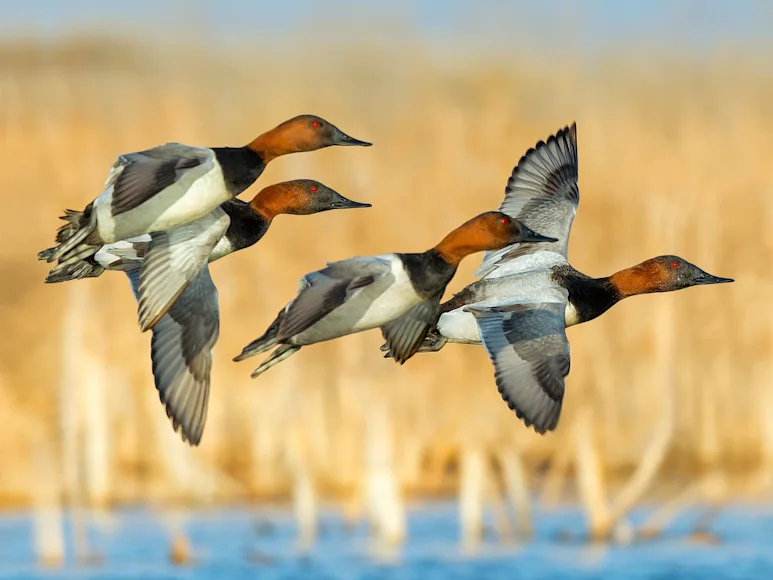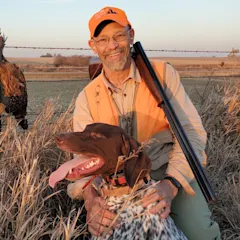CLINT BREAKS a long silence in the blind. “I read in some waterfowling magazine that this is a bucket list hunt,” he says. “Canvasbacks on Pool 9 is one of the top five hunts to do before you die.”
He gets the reaction he’s looking for, a rueful chuckle that breaks the boredom for a moment. No one on the lake is shooting. Yesterday, before I arrived, Clint’s crew hunted all day to kill a few gadwalls and teal. This morning we have one hen gadwall. The cans aren’t flying.
Six of us guard a decoy spread bobbing on unimaginatively named Big Lake, a broad, open expanse in the mile-wide maze of channels, islands, and backwaters that comprise the upper Mississippi—bordered by Iowa’s bluffs behind us and Wisconsin’s in front. It’s part of 30-mile-long Pool 9, an annual stopover spot for 300,000 canvasbacks.
When they’re on the move, cans cruise Big Lake. Clint has shown me videos on his phone from past years. Canvasbacks don’t work as much as they fly back and forth eyeing a spread from a distance, then turn almost as one to follow the long lines to the boat, bearing down at top speed before dropping their big feet to land. It’s the sight I’ve come here to see.
Best-Laid Plans
Cans decoy best to their own kind, and we have a hundred canvasback decoys out, some clipped to the two long lines running toward the middle of the lake, the rest grouped by the boats. We’ve got mallard decoys downwind of the clumped cans, and a couple of spinners too. It’s cold, and there’s plenty of northwest wind. We sit in the two boat blinds tucked against the weeds, staring at the clouds, willing birds to get up off the refuge and come out to feed.
There’s often a midday flight of canvasbacks, Clint tells me, but 1 p.m. comes and goes, and we break out stoves in both boats and make simple sandwiches. They’re just heated slices of cooked pork loin between slices of white bread, but I am cold and hungry enough that mine seems, right now, like the best sandwich I have ever eaten in my life. Lunchtime talk turns to the vagaries of migration. We offer theories of weather and the calendar. Dan speaks up. A retired park ranger and naturalist, he’s the ranking expert among us on duck migrations on the river. When he talks, we listen.
I’m the last gun in line, and by the time the hen gets to me, it has gained altitude. I’ve come loaded for bear—well, not bear, but bulls. I fold the high mallard with one shot, to cheers.
“I think,” he says carefully, “ducks migrate when the leaves change. They enjoy the fall colors.”
Food in the blind tastes better, and jokes hit funnier, especially on the slow days. I find Dan’s silly deadpan line hilarious. And with that, we sit and stare some more with diminishing hope, then pick up at the end of shooting time.
Next morning we’re back on the same point before dawn, and a couple of hours in, ducks start to fly. We shoot a decoying ringneck drake, then a mallard hen comes to the far end of the spread and escapes the volley. I’m the last gun in line, and by the time the hen gets to me, it has gained altitude. A duck overhead exposes all its vitals, and I have come loaded for bear—well, not bear, but bulls—and I fold the high mallard with one shot, to cheers from both boats. All glory is fleeting: I step out of the boat to get the duck, stumble in a deep mud-motor hole, and nearly go under the Mississippi. Once they see I’m OK, my former cheering section hoots.
I am back in the boat and dried off in time to help shoot into a small bunch of mallards, and then the flurry ends. Like everyone else on the lake, we’re back to sitting and looking up. At noon, boats start leaving. We shoot one more gadwall. By early afternoon, we’re the last boats on Big Lake, and we call it a day.
At the landing, Clint insists on trading me a fat greenhead for the ringneck I shot as we say our goodbyes. They are staying another day (they will shoot a lone spoonbill), and I’m on my way home.
“Well,” he says, “you can check this off your bucket list, anyway.”
The Bucket’s Half Full
On the trip back, I cut across the river to drive down the Wisconsin side, where the road passes close to the cans rafted by the thousands on the refuge. Canvasbacks are big ducks, and the plumage of the bulls—black, white, and reddish brown—is so neat and bold they look like freshly unboxed decoys. As I look over the ducks, I picture 50 or so barreling down on a spread and decide I should come back someday and check this hunt off the list for real.
The thing about bucket lists, though, is no one knows how much time they have to work through their list. Chances are extremely good I’ll be able to do this again, but there’s no guarantee. What if this was my one canvasback hunt? What if it was my last duck hunt, period?
I think about these past two days. Yes, it was slow, and the canvasbacks never flew. On the other hand, I saw the sunrise over a new place with friends. We laughed. We cooked in the blind. We made the most of the opportunities that did come our way. We lost no birds and let nothing get away. I fell in the Mississippi. The pair of mallards I’m bringing home make a good consolation prize for the bull can I’d hoped for.
I laid the ducks on the passenger seat so I could admire them on the drive back. They’re next to a zip-close bag of leftover Halloween candy (the best duck blind snack), a lanyard of calls festooned with bands, and the loose shells I dumped from my coat pockets. I look at this still life, and it hits me in a rush how much I love all of this. This was a duck hunt. Not a great one, but still a duck hunt, and that’s no small thing. I decide yes, I could go out on a hunt like this one. I’m not going to, though. I should be home in time to load decoys in the truck, get a decent amount of sleep, and go out again in the morning.
_Read more F&S+
stories._






